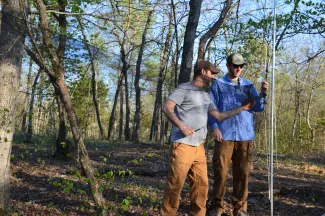A few miles outside of Stilwell, Matt Fullerton, endangered species biologist for the Oklahoma Department of Wildlife Conservation, waits near a cave entrance within the Ozark Plateau National Wildlife Refuge to survey Oklahoma bats. As the sun settles low on the horizon, bats begin to launch from their daytime roosts to feed on an abundance of night-flying insects.
"Ozark Plateau is an incredibly important spot for bats," Fullerton said. The wooded refuge and network of limestone caves -including Oklahoma's longest known cave system -hosts at least 10 species of bats, all nocturnal insect eaters.
This bat hotspot has been a regular meeting place for biologists interested in counting the number of bats using the area and monitoring the population for the effects of a relatively new bat disease known as white-nose syndrome.
For years, the refuge's trained biologists have surveyed the number of hibernating bats by quietly entering the cave in the coldest days of winter and visually counting the bats. Advancements in technology and bat detection equipment have expanded their survey window to include summer echolocation surveys, or listening surveys. More recently, they've been catching and counting bats as they come out of the caves.

Project researchers from Environmental Solutions and Innovations of Cincinnati set up a mist net near the mouth of a cave to capture bats in flight.
Bats are found on the refuge year-round, but they begin congregating in caves in the fall before they go into winter hibernation. "This 'fall swarm' allows biologists to check in on the population when bats should be in peak condition. Bats are feeding heavily now to gain weight for the upcoming winter, and they're mating," Fullerton said. Pups are born after the females wake up in spring.
U.S. Fish and Wildlife Service biologist Richard Stark and Environmental Solutions and Innovation's Kory Armstrong and Lynn Robbins have been the primary organizers of the latest survey efforts.
"Special nets are set at the mouth of the cave and near the cave entrance to catch bats as they leave the cave. When a bat is caught, it is taken to a nearby station where it is identified," Fullerton said. The identifications are confirmed by weighing the bats and measuring their forearm lengths. When a bat of a threatened or endangered species is captured, a small, unique identification band is placed on its forearm.
"If the banded bats are captured again in later surveys, it helps us better understand how many bats are in the area. If a lot of banded bats are recaptured, it indicates the population may be relatively small. If only a few banded bats are recaptured, it could mean the population is relatively large," Fullerton said.

The northern long-eared bat was recently listed as threatened under the U.S. Endangered Species Act. This bat received a metal band as part of the research project at Ozark Plateau National Wildlife Refuge in eastern Oklahoma.
One of the bats banded as part of the survey was a northern long-eared bat, which was recently added to the List of Endangered and Threatened Wildlife and Plants as a threatened species."
These bats are incredibly difficult to count in the winter," Fullerton said. "They are only a few inches long and like to hibernate in small crevices. We knew northern long-eared bats were using this cave because of the hibernation counts, but the banding portion of this study has shown that many more of these bats are using the cave than previously thought. In fact, this cave system is now thought to harbor one of the largest congregations of northern long-eared bats in the United States."
Before bats are released back into the night, biologists check for lesions and scarring on the wings associated with white-nose syndrome. The wings are carefully examined to make sure any scarring isn't from natural causes like a close encounter with a potential predator or briars. The damage is scored on a scale of 0 (no damage) to 3 (severe damage).
"White-nose syndrome affects hibernating bats and is caused by a fungus. The growing fungus wakes the bats when insects are in short supply. And because their food source is limited, the diseased bats may eventually starve," Fullerton said.
The fungus, a precursor to the disease, has been documented in seven Oklahoma counties. Two northeastern counties, Delaware and Adair, have tested positive for the disease.
"That's why the Wildlife Department is so interested in helping with this project. We're not only learning more about the northern long-eared bat, we're able to learn about the refuge's entire bat community and if the number or species of bats begins to shift."
This ongoing study was originally funded by the U.S. Fish and Wildlife Services-Refuges. The fourth year of surveys is funded in part by the federal Endangered Species -Section 6 -Traditional Grants Program grant 216338303 and by Austin Peay State University.